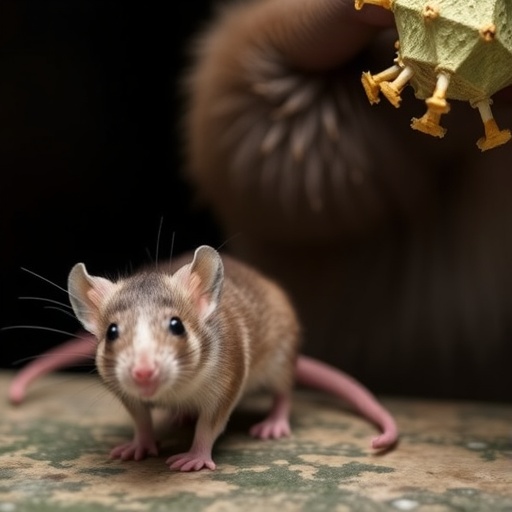PROTECT YOUR DNA WITH QUANTUM TECHNOLOGY
Orgo-Life the new way to the future Advertising by Adpathway

image: Dairy digester on a Central Valley farm helping to reduce methane emissions.
view more
Credit: Chelsea Preble/UC Berkeley
A giant, balloon-like tarp stretches over a lagoon of manure on a Central Valley dairy farm, concealing a quiet but remarkable transformation. Methane, a potent climate-warming gas, is being captured and cleaned instead of released into the atmosphere.
A new study from researchers at the University of California, Riverside shows the effectiveness of dairy digesters, which are manure ponds tightly sealed to capture and re-use the methane they produce. The study shows these systems can reduce atmospheric methane emissions by roughly 80 percent, a result that closely matches estimates California state officials have used in their climate planning.
The findings, published in Global Change Biology Bioenergy, come as California ramps up investment in methane control technologies to meet its goal of cutting emissions 40 percent below 2013 levels by the end of the decade. More than 130 of these systems are now operating across California dairies, but until now, their real-world performance hadn’t been verified this rigorously.
“The digesters can leak, and they sometimes do,” said Francesca Hopkins, a climate scientist at UCR who led the research. “But when the system is built well and managed carefully, the emissions really drop. That’s what we saw here.”
The team focused on a family-run dairy farm in Tulare County, a hot and dry region in the San Joaquin Valley that produces more milk than any other county in the United States. The researchers conducted mobile atmospheric measurements around the farm for a year before and a year after the digester system was installed in 2021, collecting hundreds of data points from a van equipped with precision gas sensors.
Methane is more than 80 times as potent as carbon dioxide at warming the atmosphere over a 20-year time frame. In California, much of the methane comes from dairy cows. The gas is not just from the burps they emit after eating, but from the way their manure is stored. When manure is held in open, water-filled pits, it breaks down without oxygen and emits methane into the air.
Covering those pits with gas-tight membranes allows the gas to be trapped, cleaned, and piped into fuel systems that often replace diesel in long-haul trucks. At the Tulare County site, researchers initially found some leaks in the system. Working with the digester operator, California Bioenergy, the team flagged the problems. Adjustments were made. The methane reductions followed.
“This was a textbook case of adaptive management,” Hopkins said. “The partnership between scientists, the company, and the farmer really made a huge difference.”
While the study affirms the potential of dairy digesters, it also acknowledges their limitations. They do not address other emissions common to dairy operations, such as ammonia or airborne particles that affect local air quality. Building the digesters is also no small task. It requires permits, capital investment, and long-term maintenance.
“They’re not for every farm,” Hopkins said. “But for dairies that can make it work, this is one of the most cost-effective ways we have to cut these greenhouse gas emissions.”
California is also expanding its monitoring capacity with satellite technology that can detect large methane leaks from space. State regulators can follow up with site operators when emissions spikes are detected.
Hopkins views the effort as a model for how climate policy, science, and industry can align when conditions are right. “There’s so much division in the climate space,” she said. “But this is a real example of cooperation that leads to measurable results.”
DOI
10.1111/gcbb.70047
Article Title
Anaerobic Digester Installation Significantly Reduces Liquid Manure Management CH4 Emissions at a California Dairy Farm
Article Publication Date
4-Jun-2025
Media Contact
Jules Bernstein
University of California – Riverside
Office: United States
DOI
10.1111/gcbb.70047
DOI
10.1111/gcbb.70047
Article Title
Anaerobic Digester Installation Significantly Reduces Liquid Manure Management CH4 Emissions at a California Dairy Farm
Article Publication Date
4-Jun-2025
.adsslot_CzsSgRdB8w{width:728px !important;height:90px !important;}
@media(max-width:1199px){ .adsslot_CzsSgRdB8w{width:468px !important;height:60px !important;}
}
@media(max-width:767px){ .adsslot_CzsSgRdB8w{width:320px !important;height:50px !important;}
}
ADVERTISEMENT
Keywords
/Applied sciences and engineering/Environmental sciences/Pollution
/Applied sciences and engineering/Environmental sciences/Pollution/Pollutants/Methane emissions
/Applied sciences and engineering/Environmental sciences/Pollution/Pollutants/Hazardous waste
/Applied sciences and engineering/Environmental sciences/Pollution/Pollutants
/Applied sciences and engineering/Environmental sciences/Pollution/Air pollution
/Applied sciences and engineering/Environmental sciences/Pollution/Air pollution/Air quality
/Applied sciences and engineering/Food science/Foods/Dairy products
/Life sciences/Organismal biology/Animals/Domesticated animals/Livestock
/Life sciences/Organismal biology/Animals/Domesticated animals
/Life sciences/Organismal biology/Animals/Domesticated animals/Livestock/Cattle
/Applied sciences and engineering/Agriculture/Farming
/Applied sciences and engineering/Agriculture/Farming/Conventional farming
/Physical sciences/Earth sciences/Atmospheric science/Atmospheric chemistry/Atmospheric gases/Greenhouse gases
/Physical sciences/Earth sciences/Atmospheric science/Atmospheric chemistry/Atmospheric gases
/Physical sciences/Earth sciences/Atmospheric science/Atmospheric chemistry/Atmospheric gases/Greenhouse gases/Atmospheric methane
bu içeriği en az 2000 kelime olacak şekilde ve alt başlıklar ve madde içermiyecek şekilde ünlü bir science magazine için İngilizce olarak yeniden yaz. Teknik açıklamalar içersin ve viral olacak şekilde İngilizce yaz. Haber dışında başka bir şey içermesin. Haber içerisinde en az 12 paragraf ve her bir paragrafta da en az 50 kelime olsun. Cevapta sadece haber olsun. Ayrıca haberi yazdıktan sonra içerikten yararlanarak aşağıdaki başlıkların bilgisi var ise haberin altında doldur. Eğer yoksa bilgisi ilgili kısmı yazma.:
Subject of Research:
Article Title:
News Publication Date:
Web References:
References:
Image Credits:
Keywords
Tags: California dairy methane captureCentral Valley dairy innovationsclimate change mitigation strategiesdairy digesters effectivenessdairy farm sustainability initiativesenvironmental impact of dairy farmingmanure management technologiesmethane emission reduction techniquesreducing greenhouse gas emissionsrenewable energy from manuresustainable agriculture practicesUC Riverside methane study


 1 month ago
10
1 month ago
10





















 English (US) ·
English (US) ·  French (CA) ·
French (CA) ·